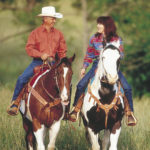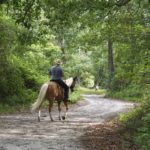If you usually compete on an unrated circuit, are you thinking of broadening your horizons by going to a couple of United States Equestrian Federation (USEF) recognized shows in your area this season? Good! As a trainer, I encourage my students to do the same thing. Your riding improves when you challenge yourself, and the competition at rated shows definitely tends to be stiffer. In addition, a USEF show’s upper divisions offer a chance to learn by watching top riders and horses.

As a licensed USEF official, though, I also notice the problems that often confront competitors who are new (and in some cases not so new!) to rated shows. So let me offer a few tips to help you make the most of those special weekends by minimizing show stress and avoiding unnecessary expense.
- Go and watch first. From ringside at a rated show where you’re thinking of riding, you’ll see how levels of competition and of turnout differ from the unrated shows you usually attend. If high-quality, multi-ring unrated shows are the norm in your area, you may notice only subtle differences between your circuit and a USEF B (or even a small A) show. If your locale offers mostly one-ring unrated shows, any rated show will be a significant step up; such issues as dealing with the logistics of multiple rings and possible class conflicts (more on this in a minute) can be especially challenging.
- If you’re uncertain which rated divisions will be most enjoyable for you, ask your trainer or another professional to evaluate your riding.
- Acquaint yourself with the USEF rules for your discipline. I know this sounds obvious, but in my steward role I’ve seen many a competitor’s weekend spoiled by simple ignorance of such basics as the USEF Drug and Medication rules. For instance, owners who assume that the rules apply only to medications may give their horses treats, such as soft drinks, that contain caffeine. They don’t realize that caffeine, however it gets into the horse, is a drug-and that, if their horse is selected for drug testing, he can then test positive for a “forbidden substance.” Many competitors are also unaware that, even if they keep their horse at home and meet a trainer at the show-as many of my students do-the USEF holds the trainer ultimately responsible in the case of a rule violation. (To obtain a copy of the USEF Drugs & Medications brochure, or for more information, call 1-800-633-2472.)
- Equipment rules-on the types of bits allowed in hunter classes, for instance-are another common stumbling block. Some judges will mark you down in a USEF class for using any Myler-type bit with snaffle rings slotted to allow a fixed rein position for a slight gag effect, even if the bit looks almost like a regular snaffle. Others only penalize obviously unconventional bits. (USEF rules give judges latitude on this issue; if you’re not familiar with a particular judge’s thinking, play it safe with a totally conventional bit.)
- Make braiding professional-or don’t braid at all. As a judge, I anticipate a slipshod performance when I see a sloppy braiding job. If you can afford it, have your horse braided. If you want to save money by braiding your horse yourself, do so ONLY if you can match the professional’s work. Otherwise you’ll make a much better impression with an unbraided but well turned-out horse. (The only USEF division requiring braiding is sidesaddle; for other classes, it’s a matter of custom and tradition.)
- Bring a groom if you possibly can. Enlist a riding friend or spouse for the weekend and you’ll have more opportunity to look around and learn. Rated shows are mentally as well as physically tiring if you’re the only one tracking your class times and scheduling changes,keeping tabs on your trainer, and looking after your horse (who deserves the best possible care during this weekend of hard work). Your turnout will also be better if someone is helping you with the details of grooming and presentation that make such a difference at this level.
- Avoid over-showing. Entering as many classes as you can makes sense at an unrated one-day show. But if you try to maintain the same pace at a rated weekend show, you and your horse will end up exhausted. (Remember, this is supposed to be fun.) On top of that, entry fees can add up to a shocking bill. Save money, and your horse’s legs, by deciding with your trainer which classes (no more than four a day at a two-day show, three a day if you’re showing longer) will benefit you most.
- Give your horse a physical and mental break whenever possible. Don’t use him as a sofa between classes; instead even if there’s no time to untack, dismount, loosen his girth, walk him to a shady spot, and let him relax until time to warm up for your next round.
- Read all information carefully: the prize list, the schedule, notices in the show secretary’s office ? A rated show costs more than an unrated show, but you can avoid unnecessary costs by checking the show’s policy on details such as post-entering classes, adds, and scratches, (For instance, you may get credit for scratching from a class if you do so the day before, but not on the day of the class.) Such policies vary slightly from show to show.
- Keep close track of what you’ve entered. If you accidentally go into the ring for a class you haven’t actually entered (which can easily happen at a multi-ring show), you may incur not only an unplanned entry fee and a post-entry surcharge, but the dreaded RDNE (rode, did not enter) penalty-in California, it’s about $15.
- Check regularly with the show office for scheduling changes that may create confli8cts between your classes; otherwise, you could end up paying for a class you didn’t get to enjoy because you were showing in another ring while it was going on.





